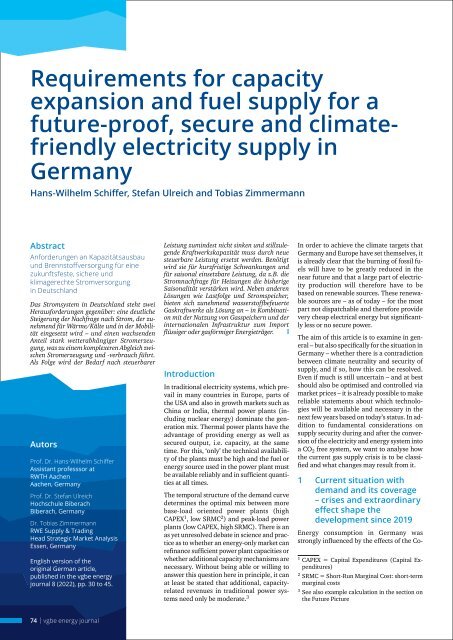vgbe energy journal 10 (2022) - International Journal for Generation and Storage of Electricity and Heat
vgbe energy journal - International Journal for Generation and Storage of Electricity and Heat. Issue 10 (2022). Technical Journal of the vgbe energy e.V. - Energy is us! NOTICE: Please feel free to read this free copy of the vgbe energy journal. This is our temporary contribution to support experience exchange in the energy industry during Corona times. The printed edition, subscription as well as further services are available on our website, www.vgbe.energy +++++++++++++++++++++++++++++++++++++++++++++++++++++++
vgbe energy journal - International Journal for Generation and Storage of Electricity and Heat.
Issue 10 (2022).
Technical Journal of the vgbe energy e.V. - Energy is us!
NOTICE: Please feel free to read this free copy of the vgbe energy journal. This is our temporary contribution to support experience exchange in the energy industry during Corona times. The printed edition, subscription as well as further services are available on our website, www.vgbe.energy
+++++++++++++++++++++++++++++++++++++++++++++++++++++++
Sie wollen auch ein ePaper? Erhöhen Sie die Reichweite Ihrer Titel.
YUMPU macht aus Druck-PDFs automatisch weboptimierte ePaper, die Google liebt.
Requirements <strong>for</strong> capacity<br />
expansion <strong>and</strong> fuel supply <strong>for</strong> a<br />
future-pro<strong>of</strong>, secure <strong>and</strong> climatefriendly<br />
electricity supply in<br />
Germany<br />
Hans-Wilhelm Schiffer, Stefan Ulreich <strong>and</strong> Tobias Zimmermann<br />
Abstract<br />
An<strong>for</strong>derungen an Kapazitätsausbau<br />
und Brennst<strong>of</strong>fversorgung für eine<br />
zukunftsfeste, sichere und<br />
klimagerechte Stromversorgung<br />
in Deutschl<strong>and</strong><br />
Das Stromsystem in Deutschl<strong>and</strong> steht zwei<br />
Heraus<strong>for</strong>derungen gegenüber: eine deutliche<br />
Steigerung der Nachfrage nach Strom, der zunehmend<br />
für Wärme/Kälte und in der Mobilität<br />
eingesetzt wird – und einen wachsenden<br />
Anteil stark wetterabhängiger Stromerzeugung,<br />
was zu einem komplexeren Abgleich zwischen<br />
Stromerzeugung und -verbrauch führt.<br />
Als Folge wird der Bedarf nach steuerbarer<br />
Autors<br />
Pr<strong>of</strong>. Dr. Hans-Wilhelm Schiffer<br />
Assistant pr<strong>of</strong>esssor at<br />
RWTH Aachen<br />
Aachen, Germany<br />
Pr<strong>of</strong>. Dr. Stefan Ulreich<br />
Hochschule Biberach<br />
Biberach, Germany<br />
Dr. Tobias Zimmermann<br />
RWE Supply & Trading<br />
Head Strategic Market Analysis<br />
Essen, Germany<br />
English version <strong>of</strong> the<br />
original German article,<br />
published in the <strong>vgbe</strong> <strong>energy</strong><br />
<strong>journal</strong> 8 (<strong>2022</strong>), pp. 30 to 45.<br />
Leistung zumindest nicht sinken und stillzulegende<br />
Kraftwerkskapazität muss durch neue<br />
steuerbare Leistung ersetzt werden. Benötigt<br />
wird sie für kurzfristige Schwankungen und<br />
für saisonal einsetzbare Leistung, da z.B. die<br />
Stromnachfrage für Heizungen die bisherige<br />
Saisonalität verstärken wird. Neben <strong>and</strong>eren<br />
Lösungen wie Lastfolge und Stromspeicher,<br />
bieten sich zunehmend wasserst<strong>of</strong>fbefeuerte<br />
Gaskraftwerke als Lösung an – in Kombination<br />
mit der Nutzung von Gasspeichern und der<br />
internationalen Infrastruktur zum Import<br />
flüssiger oder gasförmiger Energieträger. l<br />
Introduction<br />
In traditional electricity systems, which prevail<br />
in many countries in Europe, parts <strong>of</strong><br />
the USA <strong>and</strong> also in growth markets such as<br />
China or India, thermal power plants (including<br />
nuclear <strong>energy</strong>) dominate the generation<br />
mix. Thermal power plants have the<br />
advantage <strong>of</strong> providing <strong>energy</strong> as well as<br />
secured output, i.e. capacity, at the same<br />
time. For this, ‘only’ the technical availability<br />
<strong>of</strong> the plants must be high <strong>and</strong> the fuel or<br />
<strong>energy</strong> source used in the power plant must<br />
be available reliably <strong>and</strong> in sufficient quantities<br />
at all times.<br />
The temporal structure <strong>of</strong> the dem<strong>and</strong> curve<br />
determines the optimal mix between more<br />
base-load oriented power plants (high<br />
CAPEX 1 , low SRMC 2 ) <strong>and</strong> peak-load power<br />
plants (low CAPEX, high SRMC). There is an<br />
as yet unresolved debate in science <strong>and</strong> practice<br />
as to whether an <strong>energy</strong>-only market can<br />
refinance sufficient power plant capacities or<br />
whether additional capacity mechanisms are<br />
necessary. Without being able or willing to<br />
answer this question here in principle, it can<br />
at least be stated that additional, capacityrelated<br />
revenues in traditional power systems<br />
need only be moderate. 3<br />
In order to achieve the climate targets that<br />
Germany <strong>and</strong> Europe have set themselves, it<br />
is already clear that the burning <strong>of</strong> fossil fuels<br />
will have to be greatly reduced in the<br />
near future <strong>and</strong> that a large part <strong>of</strong> electricity<br />
production will there<strong>for</strong>e have to be<br />
based on renewable sources. These renewable<br />
sources are – as <strong>of</strong> today – <strong>for</strong> the most<br />
part not dispatchable <strong>and</strong> there<strong>for</strong>e provide<br />
very cheap electrical <strong>energy</strong> but significantly<br />
less or no secure power.<br />
The aim <strong>of</strong> this article is to examine in general<br />
– but also specifically <strong>for</strong> the situation in<br />
Germany – whether there is a contradiction<br />
between climate neutrality <strong>and</strong> security <strong>of</strong><br />
supply, <strong>and</strong> if so, how this can be resolved.<br />
Even if much is still uncertain – <strong>and</strong> at best<br />
should also be optimised <strong>and</strong> controlled via<br />
market prices – it is already possible to make<br />
reliable statements about which technologies<br />
will be available <strong>and</strong> necessary in the<br />
next few years based on today’s status. In addition<br />
to fundamental considerations on<br />
supply security during <strong>and</strong> after the conversion<br />
<strong>of</strong> the electricity <strong>and</strong> <strong>energy</strong> system into<br />
a CO 2 free system, we want to analyse how<br />
the current gas supply crisis is to be classified<br />
<strong>and</strong> what changes may result from it.<br />
1 Current situation with<br />
dem<strong>and</strong> <strong>and</strong> its coverage<br />
– crises <strong>and</strong> extraordinary<br />
effect shape the<br />
development since 2019<br />
Energy consumption in Germany was<br />
strongly influenced by the effects <strong>of</strong> the Co-<br />
1<br />
CAPEX = Capital Expenditures (Capital Expenditures)<br />
2<br />
SRMC = Short-Run Marginal Cost: short-term<br />
marginal costs<br />
3<br />
See also example calculation in the section on<br />
the Future Picture<br />
74 | <strong>vgbe</strong> <strong>energy</strong> <strong>journal</strong>

















